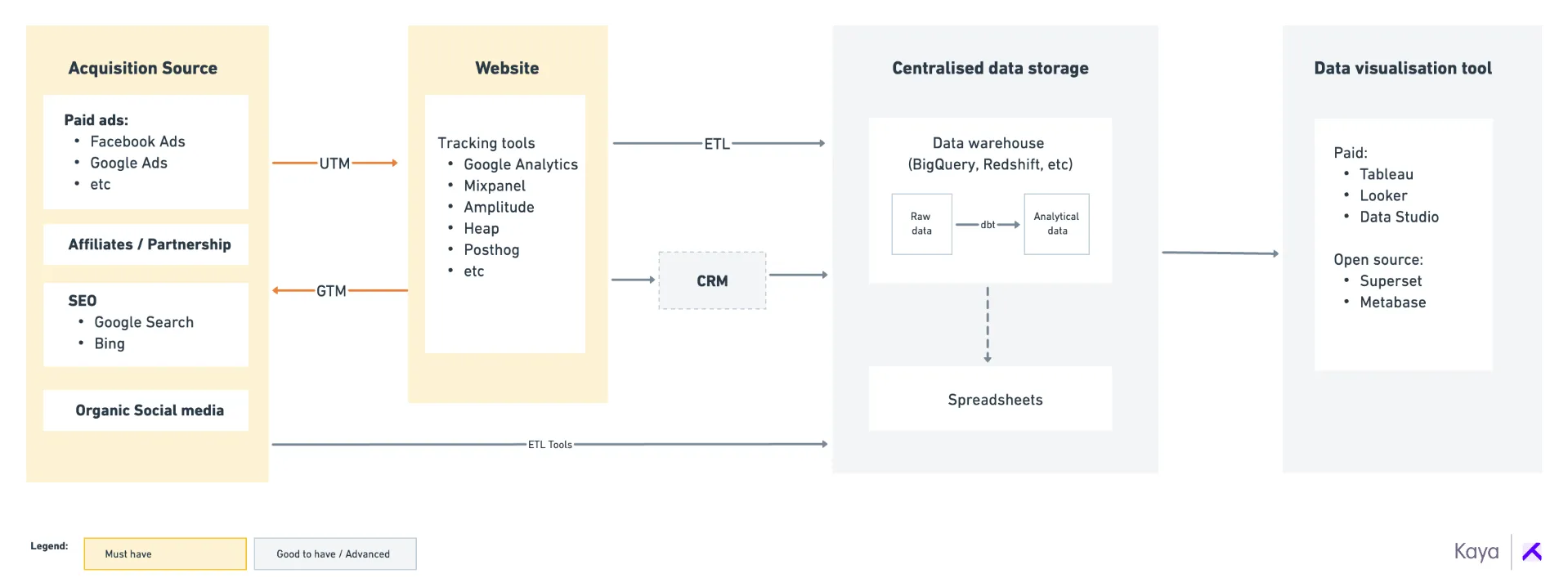You cannot solely rely on organic marketing when it comes to running a startup, especially when you are just starting out. A little kickstart can help a lot to bring in those first few leads aka revenue. And paid advertising can easily make it happen.
In this post, we’ll share our insights and 5 key areas to consider when strategizing for your paid advertising:
- When to consider paid ads
- Which platform and who to target
- How much to budget for
- What metrics to track
- How to optimize for results
What is paid advertising?
Paid advertising is a marketing strategy where businesses pay to display their ads to a targeted audience. This includes various formats like search ads, social media ads, display ads, and more.
Here are some common types of paid advertising:
- Search Engine Advertising (e.g., Google Ads)
- Social Media Advertising (e.g., Facebook, LinkedIn, TikTok)
- Display Advertising
- Video Advertising
- Native Advertising
How to Get Started with Paid Ads?
- Define clear objectives (e.g., brand awareness, lead generation)
- Choose appropriate platforms based on your target audience
- Set a realistic budget
- Create compelling ad creatives and copy
- Launch campaigns and monitor performance metrics
How does paid advertising work?
Most paid advertising platforms operate on an auction system. Advertisers bid for ad placements, and the platform displays ads based on bid amount, ad quality, and relevance.
Here are some benefits of paid advertising:
- Scalable and measurable results
- Precise audience targeting
- Quick entry to market
- Enhanced brand visibility
When should you use paid advertising for startup?
Should you start running ads?
Paid ads is a good idea in these two scenarios:
- You are early in product building: Your goal is to get early batch of users and test your messaging, targeting etc. At this point, you need to set realistic expectations with your ROAS and CAC.
- You’ve found product-market fit and ready to scale: You roughly know what resonates with your audience. At this time, you can start focusing on cost efficiency.
Paid ads can be your powerful growth channel given the right investments.
Pros:
- It is scalable, unlike other growth channels such as Product Hunt, Newsletter.
- It produces high volumes of data rapidly, helping you learn and iterate faster.
Cons:
- It takes at least 3 months for campaign to be cost efficient / profitable. Ad platforms need time to learn from your data.
- You need to allocate substantial resources (effort, time, money) to launch great campaigns.
A common pitfall for startups venturing into their first paid ad campaigns is losing momentum after a few weeks, resulting in wasted funds and missed learning opportunities.
Hence, before jumping into paid ads, ask yourself:
- Have you exhausted other cheaper growth channels that could help you improve your website conversion rates, messaging and targeting?
- Can you commit to 1 to 3 months of resources and spend?
How to choose the right paid ads platform and audience?
Choosing which type of paid ads and platform for your digital ads ultimately depends on where your users are. Think about your target audience’s demographics, interests, and behaviours, which platform suit their profiles?
The common types of paid ads include:
- Search engine advertising (Paid Search): Google ads, Microsoft or Bing ads
- Social media advertising (Paid Social): Facebook ads, LinkedIn ads, TikTok ads
- Display advertising
- Video advertising
- Native advertising
What is Paid Search?
Paid search advertising is a type of digital marketing strategy where brands bid to show their ads on search engine results pages (SERPs) like Google, Bing, and Yahoo. These ads appear when users search for specific keywords related to your product or service.
It’s great for driving high-intent traffic, generating qualified leads, and converting searchers into customers.
Key paid search channels:
- Google Ads: The most widely used platform for search ads, offering Search, Display, Shopping, and YouTube placements.
- Microsoft Ads (formerly Bing Ads): Covers Bing, Yahoo, and AOL search networks, often at lower CPCs than Google.
- Yahoo Gemini: A native and search ad platform now integrated with Verizon Media.
- Amazon Ads (Sponsored Products): While not traditional search engines, Amazon’s internal search ads target product-intent keywords.
What is Paid Social?
Paid social advertising refers to paying to display your ads on social media platforms, where you can target audiences based on demographics, interests, behaviors, and more. These ads appear in users' feeds, stories, videos, and even DMs, depending on the platform.
It’s highly effective for building brand awareness, retargeting warm audiences, and running conversion-focused campaigns.
Key paid social channels:
- Facebook & Instagram (Meta Ads): Offers highly granular targeting and various formats like image, video, carousel, and stories.
- LinkedIn Ads: Ideal for B2B advertising, with filters for job title, company size, industry, and seniority.
- TikTok Ads: Great for reaching Gen Z and younger audiences through short-form, viral video content.
- Twitter Ads (X): Used for brand awareness and conversation-driven campaigns with promoted tweets and trends.
- Snapchat Ads: Focused on visual storytelling for a younger demographic, especially through story and AR-based formats.
- Pinterest Ads: Popular for ecommerce, lifestyle, and visual discovery-driven campaigns.
Comparison between Paid Search and Paid Social
| Ad Platform | Best for | Tips |
|
Paid Search (Google, Bing) |
Targeting audience actively searching for solutions (high conversion intent) |
Gauge search volume by conducting keyword analysis using Google's Keyword Planner
|
|
Paid Social (Meta, LinkedIn, TikTok, X) |
Building brand awareness. Retargeting campaigns. Don't miss out especially if:
|
Develop high-quality assets (visuals, ad copies) relevant to your target audience. Regularly refresh ad assets to prevent ad fatigue, especially for smaller audience sizes. |
Tip: Don’t just spray-and-pray. Do a competitive analysis to find out where and who your competitors are targeting. Learn about their Ideal Customer Profile and messaging that resonates.
How to allocate budget for paid ads?
If you're just getting started with paid advertising, budgeting can feel like a shot in the dark. The key is to strike a balance: allocate enough to gather meaningful performance data, but not so much that you're overspending before validating your offer, funnel, or audience.
A budget that’s too low can delay learning. Most ad platforms like Google and Meta rely on conversion signals and learning phases to optimize delivery. If your daily spend is too small, your campaigns may take weeks to optimize or never reach optimal performance.
A budget that’s too high, on the other hand, often leads to wasted spend. Paid ads follow the law of diminishing returns. Once your target audience is saturated, adding more budget doesn’t proportionally improve performance. It might even lower ROI.
Paid Search budgeting tips:
- If your product has low search volume, a large budget may push your ads to show for broad, low-intent keywords, which can reduce conversion rates.
- Prioritize exact match or high-intent queries, and allocate more budget only when volume justifies it.
- Use tools like Google Keyword Planner or SEMrush to estimate CPCs and set realistic daily limits.
Paid Social budgeting tips:
- If your target audience is very niche, a high budget may result in:
- Ads being shown repeatedly to the same people (causing ad fatigue)
- Ads reaching broad, less-relevant audiences, reducing efficiency
- Start with a small-to-mid range budget ($20–$50/day), test different creatives and audience segments, then scale what's working.
- Use frequency caps, lookalike audiences, and retargeting layers to improve efficiency at higher spend levels.
Tip: Try out this template we use to get an estimate of budget, conversions and customer acquisition cost.
How to measure paid ads performance?
You can't improve what you don't measure.
Below a list of digital marketing metrics you should know, sorted by importance in the context of paid advertising.
Tip: Compare your metrics against industry benchmark or other channels.
| Metrics | Tips |
|
Return on Ad Spend (ROAS) = Total Revenue / Total Ad Spend *Revenue could be lifetime value (LTV) for subscription products. |
|
|
Cost per Acquisition (CPA) = Total Ad Spend / Total Conversions |
|
|
Conversion Campaign success indicator, based on completed desired actions (eg. purchase, signup) |
|
|
Conversion Rate (CVR) = (Total Conversions / Total Clicks) × 100% |
|
|
Click-through Rate (CTR) = (Total Clicks / Total Impressions) × 100% |
|
|
Cost per Click (CPC) = Total Ad Spend / Total Clicks |
|
|
Impressions Indicator of brand awareness, potential reach |
|
|
Click Shows user interest, potential conversions |
If number of clicks is too low, this means other starts are not statistically significant. So be wary of making decisions purely based on data. |
How to track your marketing KPIs effectively?
If you have started acquiring customers from multiple sources, it is essential to measure and track various KPIs and break them down by channel. This allows you to understand:
- Which channel drives the best quality traffic?
- Which channel is the most cost-effective?
- Which channel should be scaled?
Building a Minimum Viable Marketing Analytics Stack
Struggling to find answers to the questions above? Setting up a minimum viable marketing analytics stack could help.
If you’re just starting out, the end product can be as simple as having a spreadsheet where you manually update KPIs regularly (weekly/monthly). However, the key is to have reliable sources from which you can obtain each metric value.
At a later stage, you may want to invest time and money to build a data analytics pipeline that provides access to raw data and allows you to create custom dashboards.
The following diagram shows the high-level architecture of a marketing analytics stack:

Essential components
Data sources:
- Web analytics platforms: Google Analytics (free), Mixpanel, Posthog, Amplitude, Heap.
- Ensure UTM tagging is done correctly at every customer touchpoint to accurately measure channel or ad-level performance.
- Acquisition channels: Google Ads, Facebook Ads, etc.
- CRM/Sales app: Hubspot, Shopify, etc.
ETL tools to transfer data from source to destination:
- No-code ETL platforms like Airbyte or Fivetran.
- Marketing-specific tools such as Supermetrics or Funnel IO.
Reporting tools:
- Visualization tools like Google Data Studio, Metabase, or PowerBI.
- A reliable spreadsheet.
How to optimize ad campaigns?
Paid ads are not a “set and forget” channel. To drive consistent performance and improve ROI, you need to actively optimize your campaigns over time. Here’s how:
1. Iterate with A/B tests
Don’t rely on assumptions; test everything. Run A/B tests to compare different versions of your ad creatives, copy, CTAs, formats, and even landing pages. For example, test two headlines side by side to see which gets a higher CTR, or try a video ad versus a static image. Most platforms (like Meta Ads Manager and Google Ads) let you run structured experiments with statistical significance tracking. A/B testing helps you refine what resonates with your audience and reduce wasted spend.
2. Analyze competitor ads to avoid costly mistakes
Studying competitors can shortcut your learning curve. Identify which of their ads are running the longest. That’s often a signal of performance. Break down their messaging: What USPs are they emphasizing? Are they focusing on price, convenience, social proof? Tools like Meta Ad Library, Google Ads Transparency Center, and Kaya’s Competitor Ad Intelligence Tool let you monitor their creative strategy and investment levels. Use this insight to avoid obvious missteps — and capitalize on gaps they haven’t filled.
3. Use industry trends and creative shifts
Paid ad performance is influenced by timing, trends, and algorithm changes. Stay plugged into your industry’s seasonal patterns (e.g., Q4 performance spikes), as well as broader platform trends like TikTok’s preference for native-looking creatives or Meta’s push toward video-first formats. Also keep an eye on algorithm updates, privacy shifts (like iOS changes), and CPM volatility. Adjust your budget, creative formats, and targeting to stay relevant and competitive.
FAQ
Is paid search the same as paid social?
How do I find a startup marketing agency for my business?
What are paid ads?
Is $100 Enough for Facebook Ads?
Can I Get Paid for Ads?
Is $20 a Day Enough for Facebook Ads?
Final thoughts
We've just uncovered the 5 key areas to consider when strategizing for your paid advertising.
From when to run paid ads, targeting platform and audience, budgeting, metrics to campaign optimization - the exciting journey has only just begun.

